
Calcot Manor
Encyclopedia
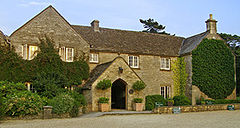
Tetbury
Tetbury is a town and civil parish within the Cotswold district of Gloucestershire, England. It lies on the site of an ancient hill fort, on which an Anglo-Saxon monastery was founded, probably by Ine of Wessex, in 681. The population of the parish was 5,250 in the 2001 census.In the Middle Ages,...
, Gloucestershire
Gloucestershire
Gloucestershire is a county in South West England. The county comprises part of the Cotswold Hills, part of the flat fertile valley of the River Severn, and the entire Forest of Dean....
, England
England
England is a country that is part of the United Kingdom. It shares land borders with Scotland to the north and Wales to the west; the Irish Sea is to the north west, the Celtic Sea to the south west, with the North Sea to the east and the English Channel to the south separating it from continental...
, near the junction of the A46
A46 road
The A46 is an A road in England. It starts east of Bath, Somerset and ends in Cleethorpes, North East Lincolnshire, but it does not form a continuous route. Large portions of the old road have been lost, bypassed, or replaced by motorway development...
and A4135 road
A4135 road
The A4135 road is a road in Gloucestershire connecting the town of Tetbury with the M5 motorway and the A38 road to the west, passing through Beverston, Dursley and Cam en route to Slimbridge,...
s (National Grid Reference ST 841180 94891). The original building was established in approximately 1300 AD by Henry of Kingswood as a tithe barn
Tithe barn
A tithe barn was a type of barn used in much of northern Europe in the Middle Ages for storing the tithes - a tenth of the farm's produce which had to be given to the church....
annex of Kingswood Abbey
Kingswood Abbey
Kingswood Abbey was a Cistercian abbey, located in the village of Kingswood near Wotton-under-Edge, Gloucestershire, England.- History :Kingswood Abbey was founded in the year 1169 by William of Berkeley in accordance with the wishes of his uncle, Roger II of Berkeley, and colonised from the...
. The estate was expanded to include a 16th century manor house
Manor house
A manor house is a country house that historically formed the administrative centre of a manor, the lowest unit of territorial organisation in the feudal system in Europe. The term is applied to country houses that belonged to the gentry and other grand stately homes...
and other buildings. Structures added in the Late Middle Ages
Late Middle Ages
The Late Middle Ages was the period of European history generally comprising the 14th to the 16th century . The Late Middle Ages followed the High Middle Ages and preceded the onset of the early modern era ....
to mid 17th century include a chapel
Chapel
A chapel is a building used by Christians as a place of fellowship and worship. It may be part of a larger structure or complex, such as a church, college, hospital, palace, prison or funeral home, located on board a military or commercial ship, or it may be an entirely free-standing building,...
, granary
Granary
A granary is a storehouse for threshed grain or animal feed. In ancient or primitive granaries, pottery is the most common use of storage in these buildings. Granaries are often built above the ground to keep the stored food away from mice and other animals.-Early origins:From ancient times grain...
and stable
Stable
A stable is a building in which livestock, especially horses, are kept. It most commonly means a building that is divided into separate stalls for individual animals...
s and other buildings. The buildings are all constructed from limestone
Limestone
Limestone is a sedimentary rock composed largely of the minerals calcite and aragonite, which are different crystal forms of calcium carbonate . Many limestones are composed from skeletal fragments of marine organisms such as coral or foraminifera....
; which locally quarried stones are typically flat and easily stacked for drystone wall purposes.
Roman Period
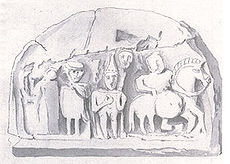
Roman Britain
Roman Britain was the part of the island of Great Britain controlled by the Roman Empire from AD 43 until ca. AD 410.The Romans referred to the imperial province as Britannia, which eventually comprised all of the island of Great Britain south of the fluid frontier with Caledonia...
presence at the site as early as the 5th century AD based upon the archeological finds of carved stones, Roman coins
Roman currency
The Roman currency during most of the Roman Republic and the western half of the Roman Empire consisted of coins including the aureus , the denarius , the sestertius , the dupondius , and the as...
and other discoveries.
Many Roman artifacts
Artifact (archaeology)
An artifact or artefact is "something made or given shape by man, such as a tool or a work of art, esp an object of archaeological interest"...
have been discovered at Calcot, some of which are now displayed at the Gloucester City Museum and the Stroud
Stroud
Stroud a town and civil parish in the county of Gloucestershire, England.Stroud may also refer to:*Stroud, New South Wales, Australia*Stroud, Ontario, Canada*Stroud , Gloucestershire, UK*Stroud...
Museum. One of the principal finds is a curved, limestone ornate bas-relief. This stone had been originally embedded in the wall of the tithe barn. This particular stone is now located in the Ashmolean Museum
Ashmolean Museum
The Ashmolean Museum on Beaumont Street, Oxford, England, is the world's first university museum...
in Oxford
Oxford
The city of Oxford is the county town of Oxfordshire, England. The city, made prominent by its medieval university, has a population of just under 165,000, with 153,900 living within the district boundary. It lies about 50 miles north-west of London. The rivers Cherwell and Thames run through...
.
The bas-relief is classified as a tombstone, on which a Roman officer is shown with arms on horseback Behind officer is the standard bearer with his insignia. As of Baddeley’s publication in 1925, the stone was still embedded within the inner barn wall
Middle Ages
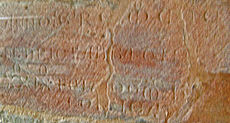
Datestone
A datestone is typically an embedded stone with the date of engraving and other information carved into it. They are not considered a very reliable source for dating a house, as instances of old houses being destroyed and rebuilt have been reported.Specific locations have often been chosen for...
can be seen in the porch of the tithe barn and reads: "ANNOGRE MCCC HENRICI ABBATIS XXIX FAI DOM H EDIFICATA", verifying founding by Abbot Henry in the year 1300 during the reign of King Edward I
Edward I of England
Edward I , also known as Edward Longshanks and the Hammer of the Scots, was King of England from 1272 to 1307. The first son of Henry III, Edward was involved early in the political intrigues of his father's reign, which included an outright rebellion by the English barons...
. The barn is a Grade II listed building, and has so-called arrow slits in the end walls.
The remains of a medieval rabbit
Rabbit
Rabbits are small mammals in the family Leporidae of the order Lagomorpha, found in several parts of the world...
warren
Warren (domestic)
A domestic warren is an artificial, enclosed establishment of animal husbandry dedicated to the raising of rabbits for meat and fur. It evolved from the Anglo-Norman concept of free warren, which had been, essentially, the equivalent of a hunting license for a given woodland.-Architecture of the...
were unearthed in 2004. when the groundworks for a new spa extension to the hotel were being excavated. An underground tunnel was found extending at least 100 metres beneath the main manor house garden terrace. The tunnel is intact as of 2004, but has not yet been fully explored. Earth bore tunnels of this type are sometimes associated with High Middle Ages
High Middle Ages
The High Middle Ages was the period of European history around the 11th, 12th, and 13th centuries . The High Middle Ages were preceded by the Early Middle Ages and followed by the Late Middle Ages, which by convention end around 1500....
abbeys, palaces, and castles as secret escape routes
Escape tunnel
An escape tunnel is a form of secret passage used as part of an escape from siege or captivity. In medieval times such tunnels are usually constructed by the builders of castles or palaces who wish to have an escape route if their domain is under attack...
if the site were under siege.
The hamlet of Calcot was listed in Domesday Book
Domesday Book
Domesday Book , now held at The National Archives, Kew, Richmond upon Thames in South West London, is the record of the great survey of much of England and parts of Wales completed in 1086...
(1086 AD), as being in the Hundred of Berkeley.
Middle ages to 18th century
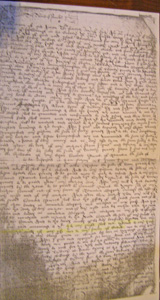
Dissolution of the Monasteries
The Dissolution of the Monasteries, sometimes referred to as the Suppression of the Monasteries, was the set of administrative and legal processes between 1536 and 1541 by which Henry VIII disbanded monasteries, priories, convents and friaries in England, Wales and Ireland; appropriated their...
in the early to middle 16th century , the Calcot property became property of the King of England, who in turn granted Calcot to Nicholas Poyntz
Nicholas Poyntz
Sir Nicholas Poyntz was a prominent English courtier during the latter part of Henry VIII's reign. There is a portrait drawing by Hans Holbein the Younger in the Royal Collection and an oil portrait after the same artist based on the drawing in the National Portrait Gallery, London...
. In 1559 Calcot was sold to Thomas Parry
Thomas Parry (Comptroller of the Household)
Sir Thomas Parry was a Comptroller of the Household to the English Queen Elizabeth I.He was knighted by Elizabeth at her accession in 1558, and held the offices of royal steward, Cofferer, Privy Counselor, Comptroller of the Household , Master of the Court of Wards and Liveries , Member of...
. Then in 1598 ownership of Calcot passed to Sir Thomas Estcourt
Thomas Estcourt
Sir Thomas Estcourt was an English lawyer and politician who sat in the House of Commons in 1624.Estcourt was the son of Thomas Estcourt of Gray's Inn and his wife Hannah Ascough..He matriculated at Magdalen College, Oxford on 29 April, 1586, aged 16 and was called to the bar at Gray's Inn in...
, who was accumulating many other properties in the parishes of Newington Bagpath. The tithe barn was struck by lightning in 1728, and restoration was completed a year later, with the datestone embedded in the porch interior wall. The entire Calcot property remained in the possession of the Estcourt Family until the early 19th century.
A 1790 drawing of the tithe barn reveals the presence of an array of seven and possibly eight arrow slits across the front face of the structure. The slits were situated somewhat higher than the front-facing windows. These arrow slits are no longer present in the restored tithe barn.
The sites and Monuments Record, SMR 2931/2, indicates that a small chapel previously existed on site, but was demolished most likely in the early 19th century. An ink drawing by Grimm
Samuel Hieronymus Grimm
Samuel Hieronymus Grimm was an 18th century Swiss topographical artist who worked in oils , watercolours, and pen and ink media.-Life and work:...
of the chapel
Chapel
A chapel is a building used by Christians as a place of fellowship and worship. It may be part of a larger structure or complex, such as a church, college, hospital, palace, prison or funeral home, located on board a military or commercial ship, or it may be an entirely free-standing building,...
in 1790 shows the medieval arches of the early chapel.
20th century to the present
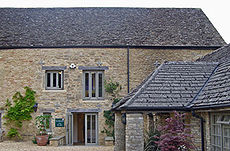
Mariemont, Ohio
Mariemont is a planned community village in Hamilton County, Ohio, United States. It includes one or two historic districts, Village of Mariemont and Mariemont Historic District. Founded in the 1920s by Mary Emery, Mariemont exhibits English architecture from Norman to classic Georgian style...
as individual roofing tiles. The tiles were used to build the roof of the Mariemont town church. Moss and lichens remained on the tiles, adding to the antique appearance wanted by Mariemont designers. Mariemont was created in imitation of the architecture of a medieval European town.
In 1970 the farm elements were relocated nearby, leaving all the old stone buildings surplus to farm requirements. The Ball family bought the Calcot estate in the early 1980s and began converting the buildings for use as an hotel, the work continuing through the next decade. Louisa and Michael Stone, previously frequent guests, bought Calcot in early 1992 and restored the tithe barn in the early 2000s. By 2006 Calcot Manor had become an upmarket hotel and tourist destination in the Cotswolds
Cotswolds
The Cotswolds are a range of hills in west-central England, sometimes called the Heart of England, an area across and long. The area has been designated as the Cotswold Area of Outstanding Natural Beauty...
.

